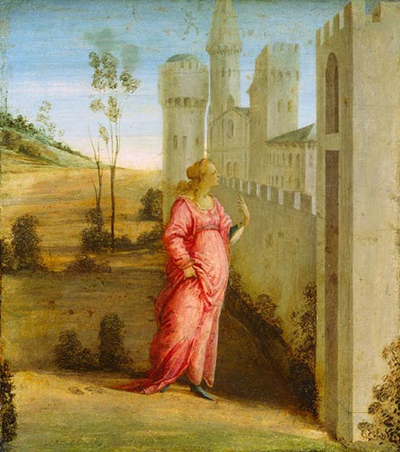Life of Esther or Scenes from the Story of Esther was a series of paintings produced in the 1470s, with contributions from both Botticelli himself and also Filippino Lippi. The individual artworks are now dispersed right across the world and rarely seen together.
In this painting we find a young maiden with her hand out, palm open. She appears to be acknowledging another who is not including in this painting, as she looks out to our right hand side. She is particularly tall, enabling her to look over the fortified wall of a building which lines the right hand side of the artwork. Botticelli was particularly skiled in incorporating architectural features into his paintings, though normally did so as background features. In the case of Esther at the Palace Gate, it serves a greater, symbolic significance and essentially refers to the barrier between this woman and the person that she is attempting to communicate with. With this artwork being a single part of a larger series, one can immediately assume that this story is continued elsewhere in the other paintings, with perhaps a cartoon-strip like quality appearing within the different, related pieces. Some of the other paintings in this series included the likes of The Triumph of Mordecai, which displays a figure in the opposite direction, from within the confines of this fortified structure.
Besides the wall and towers that sit across the right hand side of the painting, Botticelli also includes brief details of plants and trees to the left, which helps to underline how this woman is outside and seemingly all alone. A shadow is formed along the wall which perhaps gives a further symbol of her vulnerable position, standing around the darkness from the outside. The perspective is somewhat imagined and unrealistic in this piece, if you consider the towers which are much smaller than one might expect. Whilst the angles of the wall broadly follow the rules of perspective, there is not enough distance to the towers to warrant them being as small as this. Within the Early Renaissance there was a great development in the precision and accuracy of perspective within art, as previously in the Middle Ages, most scenes were flat and more akin to modern cartoons. Clearly, more development was needed even by the time of Botticelli, although accuracy to reality does not always make for better art.
Esther's Arrival in Susa (Esther at the Palace Gate) measures 48.4cm in height by 43.2 cm in width. It today is a part of the collection of the National Gallery of Canada, Ottawa, making it one of the few Botticelli paintings to be located outside of Europe and the US. This large and important institution has a fine selection of art which focuses most of the regions of Canada and Europe, with some of their highlights including the likes of Eve, the Serpent, and Death by Hans Baldung, Madonna and Child with Saint Roch and Saint Sebastian by Lorenzo Lotto, Shoeburyness Fishermen Hailing a Whitstable Hoy by JMW Turner and Forest by Paul Cezanne. Although Canadian artists are not particularly famous on the international stage, there is plenty of quality to be found within that part of the collection, and perhaps some of those stories will get more focus in the coming centuries.




